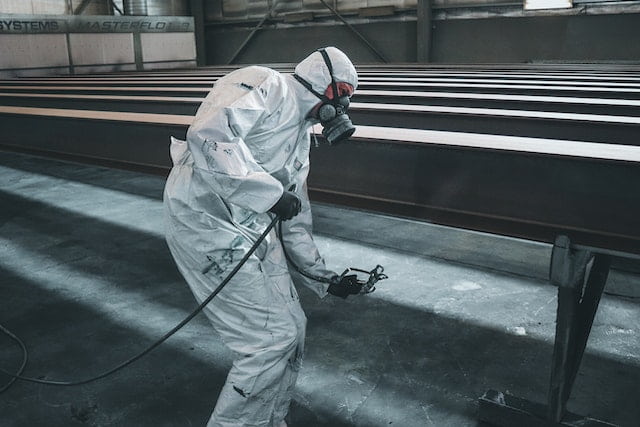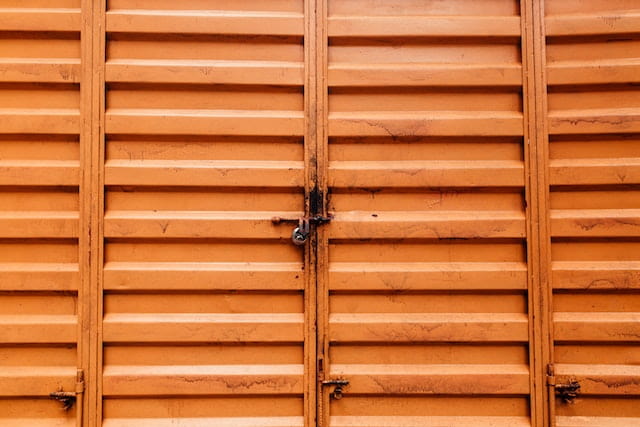You are probably looking at your worn-out metallic coat hanger, furniture, or any other metallic pieces, wondering whether to fix or discard them.
Metallic surfaces are appealing when new and painted but tend to get rusty, corroded, and tarnished over time due to exposure to the elements.
Don’t sweat it! There is a way to transform metal pieces from dull and boring into something dainty. If you get your hands on quality metallic paint, proper gear, and free time, you can get creative and breathe new life into your tired metallic pieces.
Keep reading to learn how to paint metal without spray paint, handle your projects like a pro, and receive compliments on your well-painted metal piece. Let’s dive into it.
Can You Paint Metal Without Spray Paint
Using spray paint on metal is quite convenient, but it isn’t the only way to paint metallic surfaces. You can apply brush-on paint on metal with a quality brush or foam roller. It will take you longer to paint the piece you are working on, but the results are pretty rewarding. Brush-on metal paints are available in water and oil-based formulations, depending on your preference.
How To Paint Metal Without Spray Paint
When deciding to paint metal, the first instinct is to turn to spray paint. However, you may have some leftover paint from previous projects, and it shouldn’t go to waste.
Painting metal surfaces ranging from utensils like Yeti cups to furniture without spray paint sounds confusing and tedious. That isn’t always the case.
Today, I’ll deliver you from the notion that spray paint is the only way to paint metal and teach you how to paint metal without spray paint.
Supplies
- Metal degreasers or mineral spirits
- Wire brush
- Lint-free rags
- Oil or water-based metal paint primer
- Drop cloth
- Protective gear
- Paintbrush or foam roller
- Fine-grit sandpaper or scuffing pads
- Rust remover
STEP 1: Prepare Your Workspace
Protect your work area by spreading a drop cloth and taping the places you don’t want to get paint drips and spillages. If the space is enclosed, ensure it is well-ventilated, as paints contain toxic fumes. Also, protect yourself with gloves, a dust mask or respirator, and goggles to avoid direct contact with the paint.
STEP 2: Remove Old Paint, Rust, and Dust With a Wire Brush
If you are working on a new metal piece, this step is unnecessary, but you can’t skip it with old pieces. When metal is exposed to air and the elements, it oxidizes, and a coating of rust forms over the metal.
The best way to remove the rust is by scrubbing it off with a wire brush. The wire brush loosens the rust making it easier to wipe. Work on the edges and contours with sandpaper. Keep scrubbing and wiping the particles, rust, dust, and dirt with a damp rag.
STEP 3: Clean the Metal Piece With a Degreaser or Mineral Spirits
Dip a cloth in a metal degreaser or mineral spirits and wring but leave the rag damp. Wipe the rust particles and paint dust with the damp rag, leaving the surface clean.
Don’t skip this step, even if the metal piece you are working on seems fairly clean. Paint sticks well on a clean surface, and any leftover grime interferes with paint adhesion.
If the piece you are painting is made of galvanized steel, clean the surface with white vinegar instead. White vinegar breaks down the zinc coating formed during the galvanization process.
STEP 4: Abrade the Surface With Sandpaper
Using fine-grit sandpaper, gently scrub the metal surface to create microscopic ridges for the primer and paint to adhere properly. Metal is non-porous, meaning paint can’t bind to the surface without you creating a rough surface. After sanding, wipe the sand dust with a tack rag or damp cloth.
STEP 5: Apply the Primer and Let it Dry
Identify the type of metal you are working on because different metals require different primers. Ferrous metals like steel and iron are more susceptible to rusting.
To prevent rust, metals are galvanized with an outer layer of zinc. Non-ferrous metals like copper, zinc, and stainless steel require a primer different from that used on ferrous metals.
For the metals prone to rusting, apply a layer of zinc chromate primer to prevent rusting. Then add a self-etching primer coat on ferrous and non-ferrous metal pieces. The self-etching primer can be water- or oil-based, depending on what works for you and the type of paint you want to apply.
The primer creates an even, smooth surface and makes any imperfections visible for you to rectify before applying the paint. Also, metal primer helps the paint bond better to the metal surface.
STEP 6: Paint Your Metal Surface and Let it Dry
Now, the surface is ready for painting. If the paint is too thick, consider thinning it with paint thinners to achieve consistency. Use a synthetic or foam brush to apply the paint on the metal surface.
Apply thin coats, moving the brush horizontally or vertically to prevent brush strokes. Gently wipe off the excess paint at the edge of the paint container to avoid paint drips.
Let the paint dry for at least 90 minutes before adding subsequent coats. Read the manufacturer’s recommendation on the application process and drying time.
For outdoor metals, use oil-based paint as it provides resistance to moisture, heat, harsh elements, and rust. Also, oil-based paint is more durable.
Water-based paint dries quickly and is suitable for indoor metal surfaces not exposed to heavy traffic. Acrylic paints, on the other hand, are fast-drying, durable, and toxic-free, hence best for interior metal pieces.
STEP 7: Apply the Second Coat and Let it Dry
Add a second coat of paint to even out imperfections on the initial coat. Follow the same brush strokes as you did the first coat for better consistency. Let the paint dry and cure for 36-48 hours before the metal piece is ready.
STEP 8: Seal the Paint
The sealing step is optional, but I recommend seeing it through. Sealing makes the underlying paint color pop and protects it from moisture, abrasion, cracking, peeling, and sunlight damage. Also, the sealer makes the metal surface glossier.
STEP 9: Let it Dry
Let the painted metal surface dry in a designated area. Avoid moving the piece before it dries to avoid ruining the paint. Place the drying piece in a well-ventilated and moderately humid area. It should also have the perfect temperatures and be away from direct sunlight. Environmental factors like temperatures, rain, and humidity influence paint’s drying time.

Pro Tip For Painting Metal Without Spray Paint
Painting metals is challenging even for pros like me and can be extremely difficult for newbies. Let me share some tips I use to make my metal paint jobs a success:
- When giving a new paint job to previously painted surfaces, remove any chippings and peeling. Use a wire brush or sandpaper to scrub off the paint till the surface is nice and smooth.
- The metal surface must be clean and free of oil, grease, dirt, dust, and particles. Use a TSP cleaner, metal degreaser, or damp rag with mineral spirits to clean the surface.
- Wear protective gear like a respiratory mask, gloves, and goggles to prevent inhaling toxic fumes from the paint or getting sand dust in your eyes.
- If the metal is galvanized with zinc or shiny, wipe the surface with white vinegar and scuff it with steel wool or sandpaper.
- The weather needs to be perfect for painting. High or low temperatures, humidity, and direct sunlight interfere with drying. Adverse weather conditions can cause the paint to peel, crack, or bubble.
- Rust is like mental cancer and needs to be dealt with accordingly. Apply zinc chromate primer to prevent rust before adding another coat of self-etching primer. Rust grows and spreads under the surface, causing unseen damage.
- Identify the metal piece you are working on, whether ferrous or non-ferrous. Different types of metals require different types of metal paint and primers. Check the manufacturer’s instructions to confirm suitability.
FAQs: How To Paint Metal Without Spray Paint
To make your research easier, I have answered some of the frequently asked questions below:
What Can I Use Instead of Spray Paint?
Spray painting metal is commonly used to apply paint to metal surfaces. However, you can explore options like brush-on and roll-on paint. Buy water or oil-based paint formulas and use a brush or foam roller to paint the metal.
Can You Brush the Paint on Metal?
Of course. You must mix the oil-based paint with a thinner to attain the correct consistency and apply thin coats on the metal surface. Use a smaller brush to paint the hard-to-reach areas. Acrylic and water-based paints do not need thinning; apply them directly from the container.
Can You Paint Metal With Any Paint?
You can paint metal with any specifically designed metal paints in the market. Using any other type of paint will result in premature flaking, peeling, or blistering. Also, note that direct metals use different paints. For instance, the metal paint you use for galvanized steel isn’t suitable for aluminum. Read the instructions on the can to check for suitability.
What is the Best Paint to Use on Metal Surfaces?
Oil-based metal paints are the number one choice. Oil-based paint is more durable and protects metal surfaces from rust, sunlight, heat, moisture, and water damage. Its qualities make the paint suitable for outdoor metal surfaces. The downside is that oil-based paint takes longer to dry and cure and is highly toxic. Use water-based or acrylic paints for indoor projects are they emit less toxic fumes.
Is Spray Paint Better Than Paint on Metal?
Spray paint is convenient to use in terms of time, speed, and application technique. Spray painting is less of a hassle when working on large projects. Painting using a brush or foam roller is more tedious and time-consuming.
What Kind of Paint Will Stick to Metal Surfaces?
Oil-based metal paint has superior adhesion on metallic surfaces than other paint options. Its long-lasting coating leaves the surface with a vibrant and glossy finish. Also, it protects metal against rust and water damage.
Final Thoughts: How To Paint Metal Without Spray Paint
The secret to achieving a smooth and even paint job lies in preparation. Poor preparation will get you poor results, average preparation yield average results and good preparatory stages will give you excellent results.
Painting metal surfaces with a brush or foam roller might be something other than your cup of tea, especially when working on large projects. However, if you have brush-on metal paint and some time to spare, fold your sleeves, put on your PPEs, and get to work.
This post provides all the necessary information you need to achieve excellent results painting metal without spray paint.
Happy painting!

